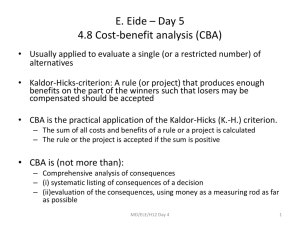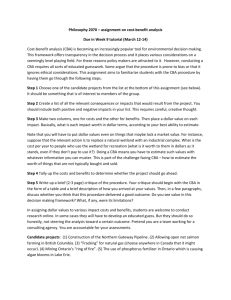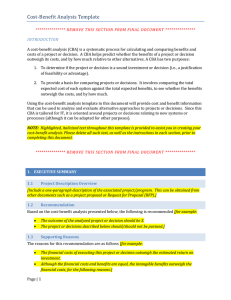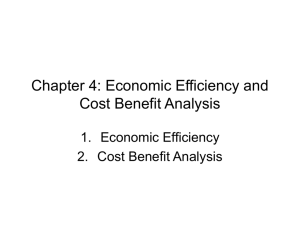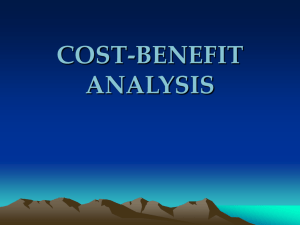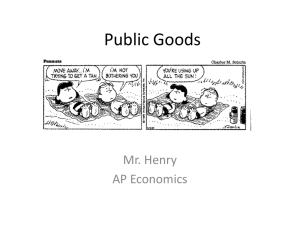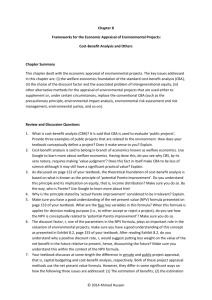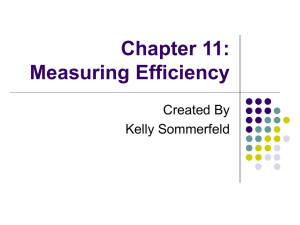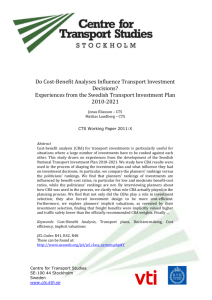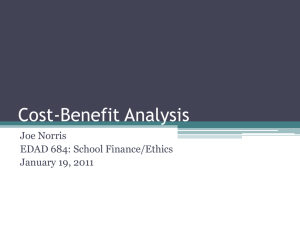Unit 3_Economic Analysis_Cost
advertisement
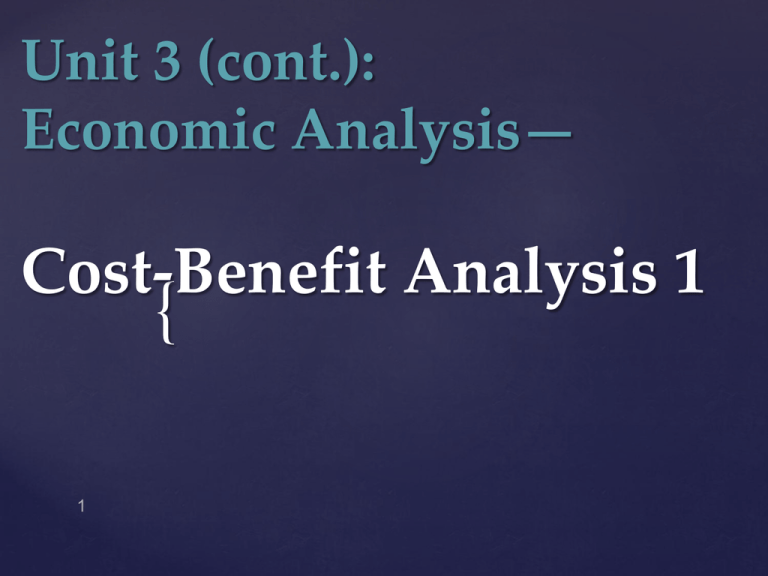
Unit 3 (cont.):
Economic Analysis—
Cost-Benefit Analysis 1
{
Meaning of Cost-Benefit
Analysis
What is Cost-Benefit Analysis?
Meaning of Cost-Benefit Analysis
Definition:
“… is a useful approach to assess whether
decisions or choices that affect the use of
scarce resources promote efficiency…
[The] analysis involves systematic
identification of policy consequences,
followed by valuation of social benefits
and costs and then application of the
appropriate decision criterion” (Fuguitt &
Wilcox, 1999: 35).
Meaning of Cost-Benefit
Analysis
Entails comparison of costs & benefits of a
single project or alternative projects
NOT just about financial analysis of
revenues and expenditures but “social’’ costs
and “social” benefits
—the gains and losses of a project as viewed
from the standpoint of society as a whole
It is used to inform decisions
Meaning of Cost-Benefit
Analysis
Where in the Project Life
Cycle do we Need to do
Cost-Benefit Analysis
(CBA)?
Who does Cost Benefit
Analysis?
Who does Cost Benefit Analysis?
Government—its goal is to promote public
interest and increase social welfare
Private corporations—some private
decisions have social goals in mind; or
government may demand it
Non-profit organizations—most of them
have social goals or depend on public funds
(e.g. environmental NGOs)
Examples of Areas Where CBA
can be Applied
Water resource projects
Transportation projects
Education programs
Pollution control projects
Endangered species preservation
Etc, etc, etc
What is the main rationale
behind Cost-Benefit Analysis as
a decision-making tool?
What is it intended to achieve?
Rationale for Cost Benefit
Analysis
EFFICIENCY is at the heart of CBA
whether benefits derived are worth the costs
used to identify most EFFICIENT alternative
What is Efficiency?
option that yields the most outputs for a given
amount of inputs
used as basis for economically rational
allocation of scarce resources
Meaning of Costs and Benefits
What is Cost?
the opportunity cost of all resources to be
used for a project
Opportunity cost = the value that
would have been derived from these
resources had they been allocated to the
next best alternative foregone
Meaning of Costs and Benefits
Benefits
positive outcomes of a project
manifestations of project objectives,
plus unintended positive consequences
Meaning of Costs and Benefits
What are Disbenefits?
undesirable (negative) consequences
(disadvantages) suffered by society or
a section of society as a result of a
project, e.g. economic losses, pollution,
nuisance, etc
usually unintended outcomes
“With & Without” vs“ Before & After”
CBA deals with incremental benefits and
incremental costs
not a before-and-after analysis: i.e. not estimation
of difference in costs and benefits b/n the time
before (baseline scenario) and the time after the
project
Incremental benefits = (benefits with the
project) minus (benefits without the project)
Incremental costs = (costs with the policy)
minus (costs without the project)
Basic Steps of CBA
Define alternatives to be evaluated
Identify all expected social costs and social
benefits
Value social benefits and costs in monetary terms
Determine appropriate CBA decision criterion(a)
Assess alternatives based on CBA decision
criteria chosen
Describe consequences that can not be valued in
monetary terms
Report results for consideration by decision
makers
Decision Criteria in Cost-Benefit
Analysis
Three common CBA-based decision
criteria:
1. Net Present Value (NPV)
2. Cost-Benefit Ratio (CBR)
3. Internal Rate of Return (IRR)
a discount rate such that NPV = 0
Desirable if IRR > actual discount rate
WHY?
